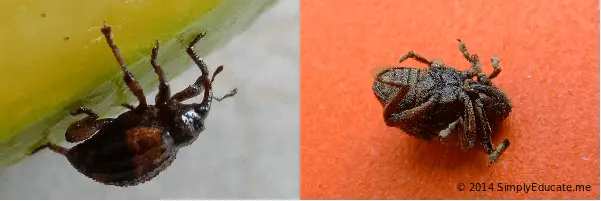This article describes the mango pulp weevil (MPW), Sternochetus frigidus, introduced to Palawan province and discovered in 1987. The weevil still lingers as a pest control problem that prevents local mango farmers from exporting their agricultural produce in other places. Find out how the MPW looks like and where it grows. I include a video to show how this pest behaves when disturbed and how fast it can move.
Research still has to find a long-term remedy to the problem of mango pulp weevil (Sternochetus frigidus) infestation in the province of Palawan in the Philippines where the world-renowned underground river is found. Pest control approaches by farmers have so far been unable to eradicate the pest at the source, which finds the edible fleshy part of the mango as its favorite breeding place. Hence, the name mango pulp weevil or MPW.
The weevil damages a part of the mango pulp thus reduce the quality of the fruit. For over two decades, mango growers could not export their agricultural produce because the mango pulp weevil will threaten the mango industry in other places.
A post-harvest pest control approach done so far to control the mango pulp weevil includes irradiation as quarantine treatment (Padilla 2012). This approach appears to be more economical compared to other post-harvest pest control treatments, such as the application of heat and fumigation. Local farmers also apply hit-and-miss approaches to control the weevil at the source.
Morphology of the Mango Pulp Weevil
How do these pests look like?
Below are pictures of the mango pulp weevil. Also, see the video of the two mango pulp weevils move from their home inside the mango pulp to once again breed and infest mango fruits as their breeding ground in the next section.

These are two of the four MPWs I have found last May 26, 2014 upon slicing several fruits from our homegrown mango trees. I can feel that they have a hard texture as I turn them around at the right angles to take photos.
The insect is quite small (6mm x 4mm) but switching my Panasonic Lumix LX5 to macro mode enabled me to take extreme close-up shots at a distance of less than one centimeter.
Overall, MPWs have dominant brown color at the underside and an orange dorsal region mottled with dark, charcoal black bands across the pitted wings. Also, the wings have rough tiny keratinous projections that probably aid them in burrowing through the soft pulp upon maturity. Their long snouts have two antennae with rounded tips. See how fast these pests could walk about in the video below.
Behavior of the Mango Pulp Weevil
I found the two samples in the pictures shown previously in just one mango fruit, occupying about two centimeters of the pulp next to the seed. Initially, I thought there was only one, but upon closer look, another weevil with neatly folded legs sprang to life after a minute or two.
If given the chance, they will fly within a few minutes and enter a state of suspended animation or diapause. Weevils do not fly great distances but usually stay close to the parent tree until the next fruiting season (Gove et al. 2007).
Consumers in Palawan can still eat at least half of the mangoes because only one side of the fruit is affected. An alternative way of consuming infested fruits is to flesh out the mango pulp and dry it (dried mangoes). The affected area is normally about 3 cm in diameter.
Preventive Measures to Control the Pest
I have not been so keen before on the presence of the mango pulp weevil in the three mango trees we have in our yard. My friend, a City Agriculturist, remarked that I should do something about the mango fruits that fall when ripe as this will infect other healthy mango trees.
Based on her remark and on the readings I made in writing this article, I recommend that consumers or mango owners should make the following measures.
- Remove all fallen fruits and destroy pests in infested fruit. Damaged fruits should be buried at least half a meter below the ground to prevent the weevil from completing its life cycle (Catindig and Heong 2005).
- Undertake indigenous ways to control weevil infestation, such as natural fumigation or bagging using newspapers or similar material. Harvest mango fruits as soon as these are mature.
- Report to authorities illegal shipments of mango from infested sources.
- Kill the pest right away when found in mango consumed.
For researchers, studying local farmers’ practices in controlling mango pulp weevil infestation can help minimize costs associated with pest control, specifically the use of synthetic pesticides. Comparing the efficacy of such practices will help identify low-cost techniques or approaches that will reduce, if not eradicate, the mango pulp weevil problem.
Natural pest control measures such as breeding ants that feed on the mango weevil (Renkang and Christian 2007) may also be explored. Are there ants species in Palawan that can qualify as weevil predators?
This ecosystem approach, particularly looking at the food web interactions, may be the more viable pest control option.
Is Banning Mango Export the Answer?
While banning the exportation of mango fruits from Palawan will prevent pest outbreak in other places, this caused a great loss to mango farmers in the province, declining at around 30% of the overall mango production. Other efficient ways to control the pest must be considered or its economic impact be examined further.
Despite the infestation, it affected only a small percentage of the mango fruits in my location. Without pesticide use, out of 300 mangoes that we have harvested at home in 2014, we found only less than 10 fruits with MPW in it. That’s only three percent.
Did the mango pulp weevil infestation go down? This is an area of investigation that requires comprehensive data sets from all over Palawan.
We may do an economic analysis to look at the actual damage caused by this pest. Banning fruit exportation may not really be the answer in recent years. Rather, an effective quarantine measure should be applied or alternative ways of selling the mango fruit, such as packaging them as dried mangos, would help.
References
Catindig, J. L. A. and K. L. Heong, 2005. Description of mango pulp weevil. Retrieved on May 27, 2014 from http://www.niaes.affrc.go.jp/techdoc/apasd/Sternochetus%20frigidus%20-B.html
Follett, P. A. (2001). Irradiation as a quarantine treatment for mango seed weevil.
Gove, T.; Joubert; J. P.; and M. S. de Beer; 2007. Literature review on mango seed weevil Sternochetus mangiferae (Fabricius) (Coleoptera: Curculionidae). SA Mango Growers’ Association Research Journal 27, 21-28.
Padilla, L. D. E., 2012. Saving the Phl Super Mango export industry from pulp weevil infestation through irradiation. Retrieved on May 27, 2014 from http://www.bar.gov.ph/digest-home/digest-archives/365-2012-1st-quarter/2055-janmar2012-phl-super-mango-export-industry
RenKang, P. and K. Christian, 2007. The effect of the weaver ant, Oecophylla smaragdina (Hymenoptera: Formicidae), on the mango seed weevil, Sternochetus mangiferae (Coleoptera: Curculionidae), in mango orchards in the Northern Territory of Australia. International Journal of Pest Management, 53(1):15-24.
© 2014 May 27 P. A. Regoniel, updated June 2, 2022
[cite]

